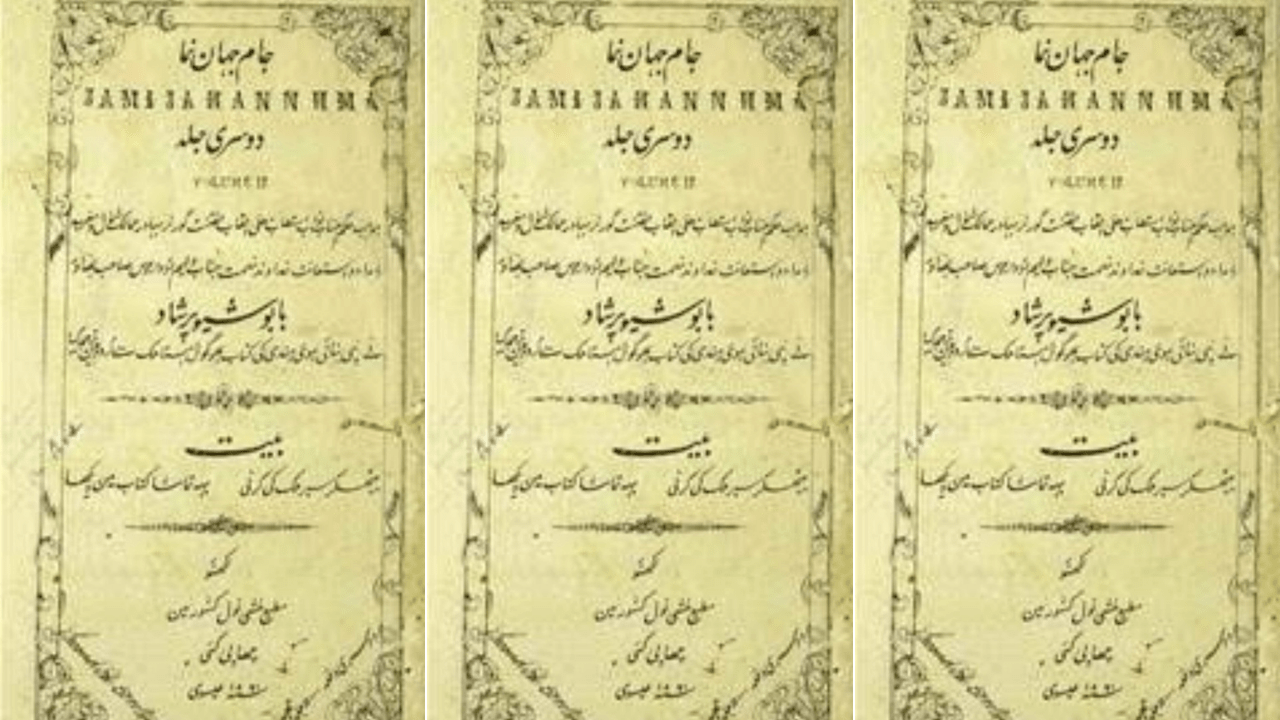Most people might be unaware, but 27th March is a historic day in the history of Urdu Journalism. On this date, the first-ever printed newspaper in the Urdu language was published exactly 200 years ago.
Urdu Journalism started in the Indian sub-continent from Calcutta with the launch of Jam-e-Jahan Numa on March 27, 1822.
In today’s India, Urdu is associated with Muslims and is considered the language of Muslims. In this context, when we look at the history of Urdu journalism, one may be surprised today to learn of its heritage and secular origins. Urdu, which has been on a decline in India over the years, and one which is much maligned by Hindutva groups, had a Hindu man who established the first journalistic publication.
Hari Hardat, a Bengali Brahmin Hindu, published the Jam-e-Jahan Numa from Calcutta on March 27, 1822. It was published under the editorship of Lala Sada Sukh Lal; a Punjabi. The printer was William Hopkins, a British national and an employee of the East India Company.
The composition of people under whom Urdu Journalism saw the light of day is really remarkable, as it truly reflects its secular characteristics. Non-Muslims had a huge contribution in the growth and development of Urdu journalism, as most of the editors in the 19th century were also not Muslims.
However, in post-independent India, Urdu language, which is widely spoken and read even today, came to be perceived as a Muslim language.
In 1822, with the publication of Jam-e-Jahan Numa from Calcutta, the journey of Urdu journalism began. Soon it spread to other parts of the subcontinent covering what we study today as the history of the 19th and 20th centuries here. During its two hundred years, Urdu journalism has seen many ups and downs and has left a deep imprint on the history, politics, economics and sociology of the subcontinent.
The history of this entire subcontinent i.e, present-day India, Pakistan, Bangladesh, Burma and Afghanistan would be incomplete without Urdu journalism. The political, economic and cultural conditions of that time truly reflect on the pages of Urdu newspapers of that time.
Urdu journalism started even before Gujarati journalism took off. The latter’s first publication, the Bombay Samachar, appeared first on July 1, 1882. Similarly, Hindi Journalism had its first newspaper – Utand Martand – published on February 9, 1826. For Tamil Journalism, the Tamil Magazine, a journal, was published in 1831.
However, Bengali journalism had set in by that time and the first newspaper in the language was the ―Bengal Gazette appeared in 1816.
After Bengali newspapers, Jam-e-Jahan Numa was the second newspaper that came out in any Indian language from undivided India. At that time, two Bengali newspapers, the Sambad Kaumudi and the Samachar Chandrika were already in circulation. So it can rightly be said that Urdu journalism held the distinction of being the second vernacular which began journalism in India.
Technologically, Urdu journalism is also at par with other vernacular journalism. India has also witnessed the digitisation of Urdu newspapers in the 21st century. There are over three dozen Urdu newspapers that have launched their e-newspapers.
Urdu journalism in its 200-year-long chequered history has seen many ups and downs. It is the only language in the country that sadly also is facing step-motherly treatment in the birth of its place. Today, it is also treated with a suspicious eye in its own country. The integrity of its antecedent is doubted often too.
In spite of all this injustice, today Urdu journalism continues to shine. Its readers owe Harihar Dutt for his idea of starting an Urdu language newspaper.
It is worth mentioning here that when Harihar Dutt launched his newspaper, he had never imagined that he was going to sow the seed of Urdu journalism and that it would also galvanize others to do the same from across the nation.
Jam-E-Jahan-Numa: The Pioneer Urdu Weekly
Jam-e-Jahan Numa – the pioneer Urdu language newspaper was printed at Mission Press, 11, Circular Road, Calcutta and published from No. 2, Colootola – a commercial place of central Calcutta.
It was a 3-sheet (6 pages) weekly of quarter size and issued on every Chahar Stambah (Wednesday). Each page of the Jam-e-Jahan Numa was divided into two columns and there were normally 22 lines in each column. The size of the paper was 20×30/8 centimetre, and it was priced at Rs.2/ per month, and the word ―Chahar Shambah (Urdu word of Wednesday) was printed on each issue below the Masthead with the date.
Harihar Dutta brought out this pioneer Urdu weekly at such a time when the language was not popular in Bengal. Urdu was prevalent only for conversation and it had not been adopted in the field of Journalism. But it was the foresight of Harihar Dutta that he introduced Urdu language as a new field in the printed newspaper form.
But his experience could not succeed at once. Therefore, after 6 issues of Urdu edition of the Jam-e-Jahannuma, he converted it into a Persian weekly. The Jam-e-Jahan Numa which was launched as an Urdu paper ceased to exist in Urdu after its 6th issue and became a Persian newspaper on May 16, 1822.
The reason behind this change was that majority of the readership was illiterate and poor. And Persian was the official language of that period and the language of the elite too. Hence it made sense.
But it seems that this condition was confined only to Bengal. In other parts of the country, Urdu had become popular by that time. So, a few years later Urdu newspapers started publishing in north India. The popularity of Urdu increased rapidly and it compelled the then colonial government to change the official language from Persian to Urdu.
The interest of Harihar Dutta in Urdu did not subside. And after one year he introduced an Urdu supplement with the Persian edition of the Jam-e-Jahan Numa. This supplement was started on May 23, 1823. It consisted of 4 pages and the pages were divided into two columns.
All types of national and international news would publish in the Jam-e-Jahan Numa. Human interest stories and news of scientific inventions would get due coverage.
The Urdu Jam-e-Jahan Numa continued to be published for around four years and eight months; starting from 23rd May 1822 to 23rd January 1828. During this period, around 241 issues were published. Out of these 241 issues, almost 100 issues carried the historical events of Britain, Europe and the Mughal emperor Jahangir.
The Persian edition consisted of 8 pages and the Urdu supplement was of 4 pages. The government was extending some financial support to this newspaper then as well. But high postal charges were a burden on the proprietor of this newspaper.
To curtail the expenditure of the newspaper, Harihar Dutt stopped the Urdu edition once again in January 1828 and continued the Persian edition. The pages of the Urdu edition were also allotted to the Persian edition. However, it finally ceased to exist forever due to non-patronage of the government.
How long the Jam-e-Jahan Numa continued is not known but Abdus Sattar Siddique in his article entitled ―Hindustan Ke Purane Akhbar, wrote that the paper continued to publish till 1845.
Condition Of Urdu
When Harihar Dutt launched the first Urdu newspaper, Urdu was not the language of the elite and educated class. It was in its evolution phase. It was not developed as a reading and writing language among the educated class, and was only used as a means of communication among the people belonging to the lower strata of society.
The readers of Urdu were few. The educated class, be it Hindus, Muslims, Sikhs or others, was Persian reading. All official work was also carried out in Persian which was the official language of that time under the British.
In fact, reading and writing Urdu was considered demeaning during that period, and the educated class considered it an insult to use Urdu, as it was the language of the masses and ordinary people. All official communiqué was done in Persian only.
The nobility would consider the use of Urdu language as below the standard action. Moreover, newspaper reading habit was also not developed by that time. Even the elite did not have time to read newspapers or to know about society in general. Producing a newspaper in Urdu was also not an easy task at that time, hence.
Before the commencement of Jam-e-Jahan Numa, there were a few handwritten newspapers- not printed, which were basically written for the nobility and the rich. These handwritten newspapers were written by a band of writers who were called calligraphers. It was a tiresome and time-consuming act, so the number of copies of these papers that were sold was small.
Even the cost of producing these handwritten newspapers was very high, which was another reason which made it out of reach of the common people. These handwritten papers were the only source of information for the nobility and the rich class as well.
We have to keep this fact in mind while reading about Urdu journalism, when Harihar Dutt published the Jam-e-Jahan Numa, the concept of reading a newspaper had not turned into a habit. So, in a way, after Bengali, it was Urdu journalism that appeared on the horizon and changed things.
This article first appeared in The Siasat Daily. Published here with the author’s permission.
Related
The author has published a research study on Urdu journalism in India, which is available on UGC’s website. He has also written a book titled "The Origin & Growth of Urdu Press in Kolkata", which was published by the Calcutta Press Club and released by former President Dr APJ Abdul Kalam. He can be contacted at facultyzafar@gmail.com












































